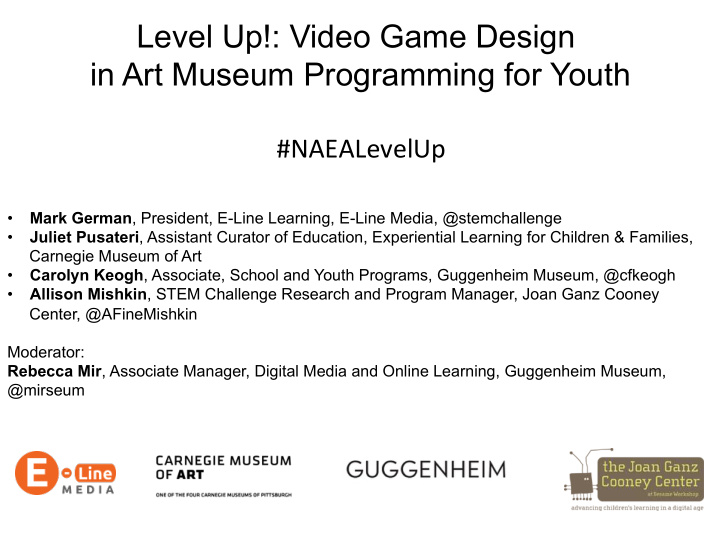



Level Up!: Video Game Design in Art Museum Programming for Youth #NAEALevelUp • Mark German , President, E-Line Learning, E-Line Media, @stemchallenge • Juliet Pusateri , Assistant Curator of Education, Experiential Learning for Children & Families, Carnegie Museum of Art • Carolyn Keogh , Associate, School and Youth Programs, Guggenheim Museum, @cfkeogh • Allison Mishkin , STEM Challenge Research and Program Manager, Joan Ganz Cooney Center, @AFineMishkin Moderator: Rebecca Mir , Associate Manager, Digital Media and Online Learning, Guggenheim Museum, @mirseum
Challenge Overview Video View at Pi3sburgh Regional Spotlight 3 www.stemchallenge.org 3
Challenge Concept Game design compe<<on for middle and high • school students as individuals or teams. Design and make original, playable games, or • wriDen game designs about any subject. Games can be created using any game plaForm • and judges will select winners. Winners receive cash prizes, dona<ons to • suppor<ng organiza<ons, and in-kind prizes. Provide online resources and facilitate 40+ game • design workshops for youth, educators, and families across the country, including a PiDsburgh regional spotlight. 4 www.stemchallenge.org 4
Why Game Design? 5 www.stemchallenge.org
Art and Game Design 6 www.stemchallenge.org 6
Research Goals • Three Areas of Analysis : Reach, Mo<va<onal Impact, Educa<onal Impact. • Mixed-Methods Research : Interviews, surveys, par<cipant observa<on. • Research Team: Interviewers and observers at 50% of workshops, survey administered at 100% of workshops. • Research Design : Case study approach to iden<fy curriculum’s impact when delivered across seXngs. 20 www.stemchallenge.org 20
Overall Results • Enhanced game knowledge • Highly applicable skills outside of workshop context • Changed students’ aXtudes towards museums • ADracted underrepresented STEM audiences 21 www.stemchallenge.org 21
Venue Level Impacts General Trends Enhanced excitement about STEM • Events Facility to support STEM and game • design learning ADracted new (and now returning • audiences) Strong impacts on future • programming decisions Sustainability for future game design • ini<a<ves 22 www.stemchallenge.org 22
Teamwork Skills • Results – Greater apprecia<on for and ability to work in teams. • Mechanisms – Excitement for workshop concept translated to collabora<on. • Evidence – 3 student response cards emphasized the friends they made and the games that their friends designed. – No observed difficul<es working together even though all students worked with students they had not met before. 23 www.stemchallenge.org 23
Systems Thinking • Results – Deeper understanding of systems thinking. • Mechanisms – Extended metaphor: Games and Museum Systems. – Physical experience with learning concept. • Evidence – Deeper use of vocabulary during group conversa<ons. – More complex games emerged from museum workshops. 24 www.stemchallenge.org 24
IteraLve Design and CreaLng for an Audience • Results – Understanding and excitement for the itera<ve design process. • Mechanisms – Workshop structure emphasizes itera<ve process. • Evidence – Venue tour emphasizes connec<ons between design choices and ar<st ra<onale. – Student Feedback emphasized both concepts. 25 www.stemchallenge.org 25
Level Up!: Video Game Design in Art Museum Programming for Youth #NAEALevelUp • Mark German , markgerman@elinemedia.com • Juliet Pusateri , pusaterij@cmoa.org • Carolyn Keogh, ckeogh@guggenheim.org, @cfkeogh • Allison Mishkin , allison.mishkin@sesame.org, @AFineMishkin • Rebecca Mir , rmir@guggenheim.org, @mirseum
Recommend
More recommend